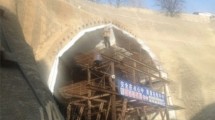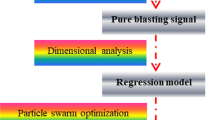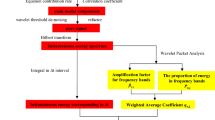Abstract
In the present study of peak particle velocity (PPV) and frequency, an improved algorithm (principal empirical mode decomposition, PEMD) based on principal component analysis (PCA) and empirical mode decomposition (EMD) is proposed, with the goal of addressing poor filtering de-noising effects caused by the occurrences of modal aliasing phenomena in EMD blasting vibration signal decomposition processes. Test results showed that frequency of intrinsic mode function (IMF) components decomposed by PEMD gradually decreases and that the main frequency is unique, which eliminates the phenomenon of modal aliasing. In the simulation experiment, the signal-to-noise (SNR) and root mean square errors (RMSE) ratio of the signal de-noised by PEMD are the largest when compared to EMD and ensemble empirical mode decomposition (EEMD). The main frequency of the de-noising signal through PEMD is 75 Hz, which is closest to the frequency of the noiseless simulation signal. In geotechnical engineering blasting experiments, compared to EMD and EEMD, the signal de-noised by PEMD has the lowest level of distortion, and the frequency band is distributed in a range of 0–64 Hz, which is closest to the frequency band of the blasting vibration signal. In addition, the proportion of noise energy was the lowest, at 1.8%.
Similar content being viewed by others
References
Blair DP (2015), “The Free Surface Influence on Blast Vibration,” International Journal of Rock Mechanics and Mining Sciences, 77: 182–191.
Bayer FM, Kozakevicius AJ and Cintra RJ (2019), “An Iterative Wavelet Threshold for Signal De-Noising,” Signal Processing, 162: 10–20.
Bi F, Li L, Zhang J and Ma T (2015), “Source Identification of Gasoline Engine Noise Based on Continuous Wavelet Transform and EEMD-Robust ICA,” Applied Acoustics, 100: 34–42.
Chen Y and Yu YX (2007), “Characteristics of Response Spectra for Long-Periods of Main-Shock Recordings of the Chi-Chi Earthquake,” Earthquake Engineering and Engineering Vibration, 6(2): 111–121.
Cheng JS, Yu DJ and Yang Y (2006), “Research on the Intrinsic Mode Function (IMF) Criterion in EMD Method,” Mechanical Systems and Signal Processing, 20(4): 817–824.
Cohen L and Loughlin P (2013), “Time-Frequency Analysis: Theory and Applications,” The Journal of the Acoustical Society of America, 134(5): 4002.
Cui HY, Qiao YY, Yin YM and Hong M (2016), “An Investigation of Rolling Bearing Early Diagnosis Based on High-Frequency Characteristics and Self-Adaptive Wavelet De-Noising,” Neurocomputing, 216: 649–656.
Damasevicius R, Napoli C, Sidekerskienė T and Wozniak, M (2017), “IMF Mode Demixing in EMD for Jitter Analysis,” Journal of Computational Science, 22: 240–252.
Ding H, Huang Z and Song Z (2007), “Hilbert—Huang Transform Based Signal Analysis for the Characterization of Gas-Liquid Two-Phase Flow,” Flow Measurement and Instrumentation, 18: 37–46.
Elad M and Aharon M (2006), “Image Denoising via Sparse and Redundant Representations over Learned Dictionaries,” IEEE Transactions on Image Processing: A Publication of the IEEE Signal Processing Society, 15(12): 3736–3745.
Ercelebi E (2004), “Electrocardiogram Signals De-Noising Using Lifting-Based Discrete Wavelet Transform,” Computers in Biology and Medicine, 34(6): 479–493.
Fuentes-García M, Macia-Fernandez G and Camacho J (2018), “Evaluation of Diagnosis Methods in PCA-Based Multivariate Statistical Process Control,” Chemometrics and Intelligent Laboratory Systems, 172: 194–210.
Gonzalez-Moreno A, Aurtenetxe S, Lopez-Garcia ME, Del Pozo F, Maestu F and Nevado A (2014), “Signal-to-Noise Ratio of the MEG Signal After Preprocessing,” Journal of Neuroscience Methods, 222: 56–61.
Gómez-Chova L, Santos-Rodríguez R and Camps-Valls G (2018), “Signal-to-Noise Ratio in Reproducing Kernel Hilbert Space,” Pattern Recognition Letters, 112: 75–82.
Han JP, Zheng PJ and Wang HT (2014), “Structural Modal Parameter Identification and Damage Diagnosis Based on Hilbert-Huang Transform,” Earthquake Engineering and Engineering Vibration, 13(1): 101–111.
Hotelling H (1936), “Simplified Calculation of Principal Components,” Psychometrika, 1(1): 27–35.
Hu X, Peng S and Hwang WL (2012), “EMD Revisited: A New Understanding of the Envelope and Resolving the Mode-Mixing Problem in AM-FM Signals,” IEEE Trans. Signal Process, 60(3): 1075–1086.
Huang NE, Chen CC and Huang K et al. (2001), “A New Spectral Representation of Earthquake Data: Hilbert Spectral Analysis of Station TCU129, Chi-Chi, Taiwan, 21 September 1999,” Bulletin of the Seismological Society of America, 91(5): 1310–1338.
Huang NE, Shen Z and Long SR, et al. (1998), “The Empirical Mode Decomposition and the Hilbert Spectrum for Nonlinear and Non-Stationary Time Series Analysis,” Proceedings of the Royal Society A, 454: 903–995.
Li N, Yang J and Zhou R (2016), “Determination of Knock Characteristics in Spark Ignition Engines: An Approach Based on Ensemble Empirical Mode Decomposition,” Measurement Science & Technology, 27(4): 045109. https://doi.org/10.1088/0957-0233/27/47045109
Liang QG, Li and Li DW (2013), “Effect of Blast-Induced Vibration from New Railway Tunnel on Existing Adjacent Railway Tunnel in Xinjiang, China,” Rock Mechanics and Rock Engineering, 46: 19–39.
Liu YJ, Chen T and Yao Y (2014), “Nonlinear Process Monitoring and Fault Isolation Using Extended Maximum Variance Unfolding,” Journal of Process Control, 24: 880–891.
Maćkiewicz A and Ratajczak W (1993), “Principal Components Analysis (PCA),” Computers and Geosciences, 19(3): 303–342.
Mateo C and Talavera JA (2018), “Short-Time Fourier Transform with the Window Size Fixed in the Frequency Domain,” Digital Signal Processing, 77: 13–21.
Momeni Massouleh S, Hosseini Kordkheili SA, Navazi HM (2018), “A Fast Online Bandwidth Empirical Mode Decomposition Scheme for Avoidance of the Mode Mixing Problem,” Proceedings of the Institution of Mechanical Engineers, Part C: Journal of Mechanical Engineering Science, 232(20): 3652–3674.
Nagarajaiah S and Basu B (2009), “Output Only Modal Identification and Structural Damage Detection Using Time Frequency & Wavelet Techniques,” Earthquake Engineering and Engineering Vibration, 8(4): 583–605.
Park D, Jeon B and Jeon S (2009), “A Numerical Study on the Screening of Blast-Induced Waves for Reducing Ground Vibration,” Rock Mechanics & Rock Engineering, 42: 449–473.
Peng JG, Wang WL and Min Fang (2012), “Hilbert-Huang Transform (HHT) Based Analysis of Signal Characteristics of Vortex Flowmeter in Oscillatory Flow,” Flow Measurement and Instrumentation, 26: 37–45.
Shao JD and Rong G (2009), “Nonlinear Process Monitoring Based on Maximum Variance Unfolding Projections,” Expert Systems with Applications, 36(8): 11332–11340.
Shi PM, An SJ, Li P and Han DY (2016), “Signal Feature Extraction Based on Cascaded Multi-Stable Stochastic Resonance Denoising and EMD Method,” Measurement, 90:318–328.
Spiegelberg J and Rusz J (2017), “Can We Use PCA to Detect Small Signals in Noisy Data,” Ultramicroscopy, 172: 40–46.
Tian PF, Zhang L, Cao XJ and Yi NN (2015), “The Application of EMD-CIIT Lidar Signal Denoising Method in Aerosol Detection,” Procedia Engineering, 102:1233–1237.
Wang W and Liu LJ (2019), “Fourier Transform and Valuations,” Journal of Mathematical Analysis and Applications, 70(2): 1167–1184.
Wei CH, Chen JG and Song ZH (2016), “Developments of Two Supervised Maximum Variance Unfolding Algorithms for Process Classification,” Chemometrics and Intelligent Laboratory Systems, 159: 31–44.
Wise BM, Ricker NL, Veltkamp DF, et al. (1990), “A Theoretical Basis for the Use of Principal Component Models for Monitoring Multivariate Processes,” Process Control and Quality, 1: 41–51.
Wu ZH and Huang NE (2009), “Ensemble Empirical Mode Decomposition: A Noise-Assisted Data Analysis Method,” Advances in Adaptive Data Analysis, 1(1): 1–41.
Yan P, Lu WB, Zhang J, et al. (2017), “Evaluation of Human Response to Blasting Vibration from Excavation of a Large Scale Rock Slope: A Case Study,” Earthquake Engineering and Engineering Vibration, 16(2): 435–446.
Yao Q, Yang XG and Li HT (2015), “Comparative Analysis on the Comfort Assessment Methods and Standards of Blasting Vibration,” Journal of Vibroengineering, 17(2): 1017–1036.
Zhai MY (2014), “Seismic Data Denoising Based on the Fractional Fourier Transformation,” Journal of Applied Geophysics, 109: 62–70.
Zhang SH, Liu LS and Zhong QL (2019), “Energy Distribution Characteristics of Blast Seismic Wave on Open Pit Slope,” Journal of Vibration and Shock, 38(7): 224–232. (in Chinese)
Zhong JJ, Song J, You CX, et al. (2014), “Wavelet De-Noising Method with Threshold Selection Rules Based on SNR Evaluations,” Journal of Tsinghua University, 54(2): 259–263. (in Chinese)
Zhou JR, Lu WB, Yan P, et al. (2016), “Frequency Dependent Attenuation of Blasting Vibration Waves,” Rock Mechanics & Rock Engineering, 49: 4061–4072.
Acknowledgement
This work is supported by the National Natural Science Foundation of China (52064015, 51404111), the Jiangxi Provincial Natural Science Foundation (20192BAB206017), the Scientific Research Project of the Jiangxi Provincial Education Department (GJJ160643), the Program of Qingjiang Excellent Young Talents, and Jiangxi University of Science and Technology (JXUSTQJYX2016007). The authors wish to express their thanks to all of these supporting institutions. Additionally, special thanks go to the editor and the reviewers of this study, and for all their useful comments, which substantially improved the manuscript.
Funding
National Natural Science Foundation of China under Grant Nos. 52064015 and 51404111, Jiangxi Provincial Natural Science Foundation under Grant No. 20192BAB206017, Scientific Research Project of Jiangxi Provincial Education Department under Grant No. GJJ160643, and the Program of Qingjiang Excellent Young Talents, Jiangxi University of Science and Technology under GrantNo. JXUSTQJYX2016007
Author information
Authors and Affiliations
Corresponding author
Rights and permissions
About this article
Cite this article
Wenhua, Y., Lei, Y., Zhenhuan, W. et al. Geotechnical engineering blasting: a new modal aliasing cancellation methodology of vibration signal de-noising. Earthq. Eng. Eng. Vib. 21, 313–323 (2022). https://doi.org/10.1007/s11803-022-2094-3
Received:
Accepted:
Published:
Issue Date:
DOI: https://doi.org/10.1007/s11803-022-2094-3




